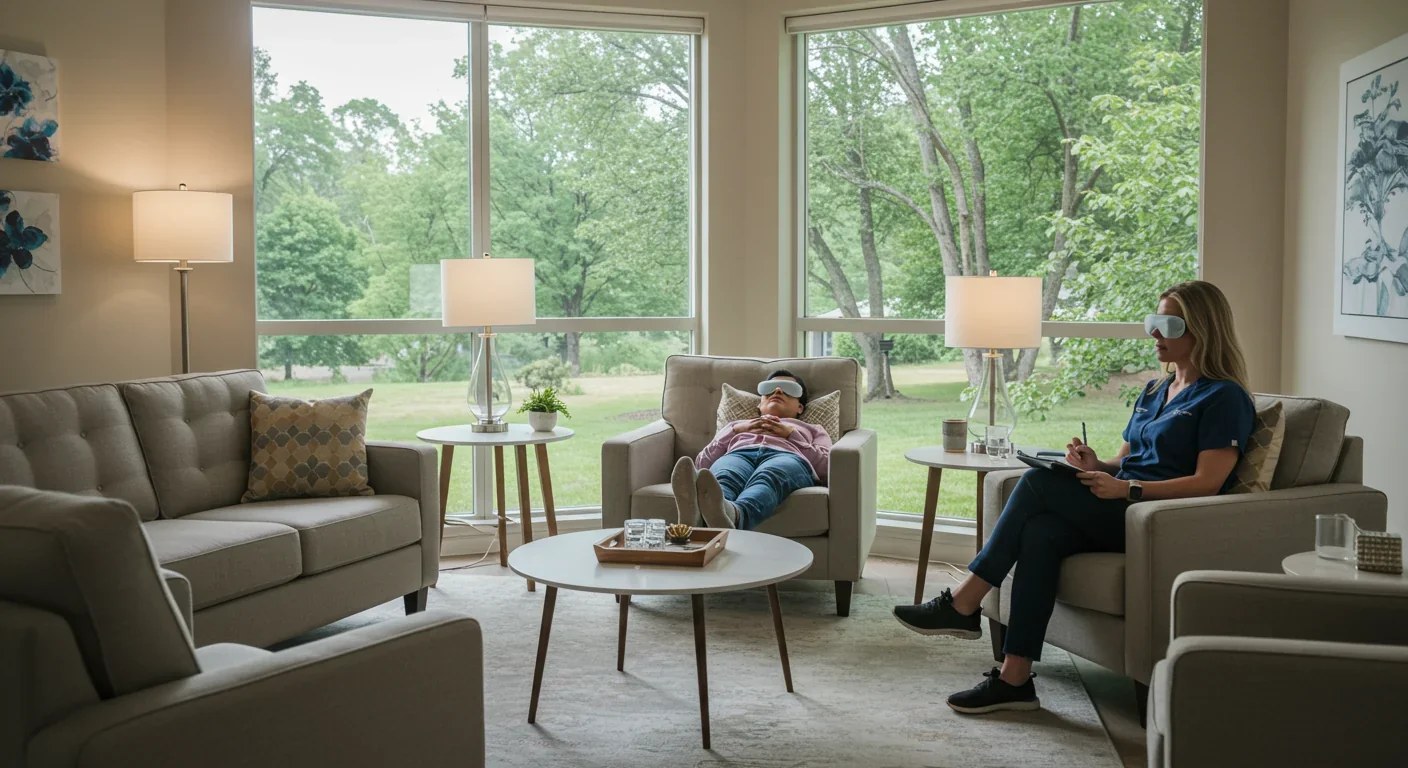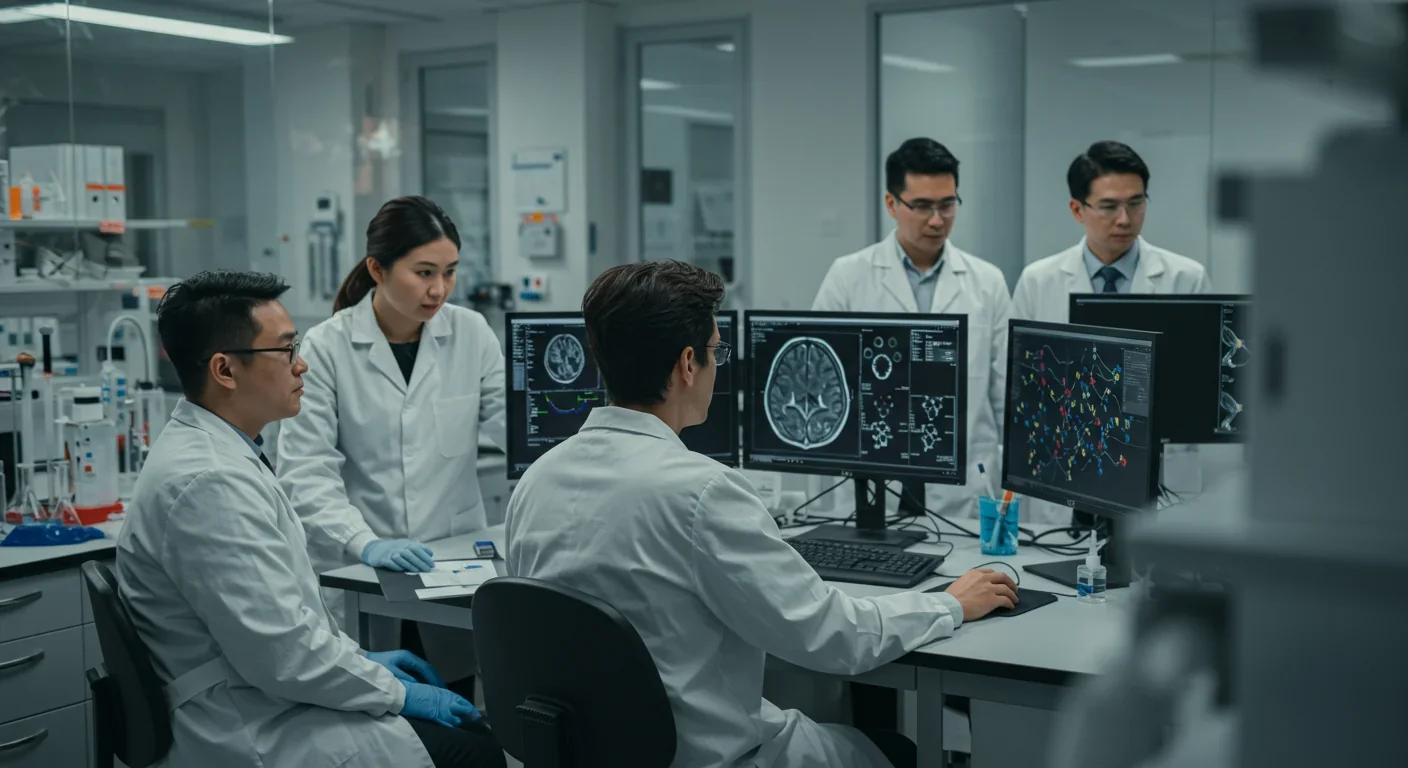Epigenetic Clocks Predict Disease 30 Years Early

TL;DR: Psychedelic medicine is transforming mental health treatment with single-dose psilocybin therapies showing 80%+ response rates for depression and PTSD, lasting years compared to daily conventional medications. FDA approval could arrive by 2027-2028, fundamentally changing psychiatric care from chronic symptom management to time-limited transformative interventions.

A recent study tracking patients over five years reveals that twelve out of eighteen participants remained symptom-free after receiving psilocybin therapy for depression. That's not just interesting. It's the kind of data that makes psychiatrists sit up and rethink everything they know about treating mental illness. Because traditional antidepressants work for only about half of patients and require daily dosing for years, often decades. We're watching a fundamental shift in how medicine approaches the human mind.
COMPASS Pathways just announced their Phase 3 trial results for COMP360, their synthetic psilocybin formulation. A single 25-milligram dose produced significant reductions in depression symptoms six weeks later. The FDA granted it Breakthrough Therapy designation, which means regulators see it as substantially better than existing treatments for serious conditions. That designation doesn't come easy.
The Phase 2 PTSD study shows even more striking numbers. Response rates hit 81.8% at week four and 77.3% at week twelve. Remission rates, meaning patients scored below clinical thresholds for PTSD, reached 63.6% initially and 54.5% at three months. Compare that to conventional PTSD treatments where response rates hover around 30-40% and you understand why researchers are calling this paradigm-shifting.
The mechanism involves neuroplasticity enhancement. Psilocybin doesn't just alter serotonin signaling through 5-HT2A receptors. It engages TrkB receptors, nonserotonergic targets that promote actual structural changes in neurons. Brain imaging studies document increased dendritic spine density and synaptic connectivity that persist long after the drug clears your system.
Between the 1950s and early 1970s, psychiatrists conducted over 1,000 clinical studies involving roughly 40,000 patients using LSD and psilocybin. Research from that era showed promising results for alcoholism, end-of-life anxiety, and depression. Then the Controlled Substances Act of 1970 classified these compounds as Schedule I, defined as having no accepted medical use and high abuse potential.
For fifty years, an entire generation of psychiatrists trained without ever considering psychedelics as therapeutic tools. The knowledge base built by early pioneers like Stanislav Grof and Humphry Osmond became historical footnote rather than foundation. Patients suffering from treatment-resistant conditions had no access to what might have been effective interventions.
The modern resurgence started quietly. Johns Hopkins established its Center for Psychedelic and Consciousness Research in 2000, initially studying psilocybin's effects on mystical experiences. Imperial College London launched similar work. By 2010, preliminary data suggested these weren't just interesting psychological phenomena but potentially therapeutic mechanisms.
What changed? Rigorous methodology. Early psychedelic research often lacked proper controls, blinding protocols, and standardized outcome measures. Modern trials use validated psychiatric assessment tools like the CAPS-5 for PTSD and MADRS for depression. They include placebo controls, though blinding remains challenging when the drug produces obvious subjective effects. They track adverse events systematically and follow patients for extended periods.
The therapeutic protocol combines pharmacology with psychology in ways traditional psychiatry doesn't. Patients receive 13 hours of psychotherapy alongside psilocybin sessions in current trials. They're not just taking a pill. They're undergoing a carefully structured experience with trained therapists present throughout.
The neurobiological mechanisms involve multiple systems. Psilocin, the active metabolite, acts as a partial agonist at serotonin receptors but shows biased agonism, meaning it selectively activates certain downstream signaling pathways. This specificity might explain why therapeutic effects differ from the broader serotonergic activity of SSRIs.
The drug increases neural plasticity during a critical window. Studies using functional MRI show decreased activity in the default mode network, the brain system responsible for self-referential thinking and rumination. In depression and PTSD, this network becomes hyperactive, trapping patients in negative thought patterns. Psilocybin temporarily disrupts those patterns, creating an opportunity for new neural pathways to form.
Critically, the therapeutic effects outlast the drug's presence by months or years. That suggests it's not simply suppressing symptoms like traditional medications but facilitating lasting psychological and neurological change.

Johns Hopkins researchers tracked outcomes in multiple studies. One trial focused on cancer patients with existential distress and depression. Six months after a single psilocybin session, 80% of participants showed clinically significant decreases in depressed mood and anxiety. At the long-term follow-up, these improvements largely persisted.
The COMP360 program tested 10mg and 25mg doses systematically. Both proved safe with no serious adverse events. The most common side effects were headache, nausea, and dizziness, typically mild and resolving within 24 hours. The higher dose showed greater efficacy, suggesting a dose-response relationship.
For anxiety disorders, LSD research recently published showed a single 200-microgram dose reduced anxiety symptoms substantially. NPR reported that improvements lasted months, with participants describing the experience as helping them gain new perspectives on their anxiety triggers.
But the regulatory path isn't smooth. The FDA declined approval for Lykos Pharmaceuticals' MDMA-assisted therapy for PTSD in 2024, citing study design concerns not previously identified. Rick Doblin of MAPS described it as "changing the goalposts." The FDA's Complete Response Letter raised questions about the control arm and blinding integrity.
This setback reveals the challenges psychedelic developers face. How do you blind a trial when the drug produces such distinctive subjective effects? What constitutes an appropriate control when the therapeutic model combines pharmacology and intensive psychotherapy? These methodological puzzles don't have easy answers.
If approved, psychedelic therapies would fundamentally alter psychiatric practice. Instead of daily medication management, treatment might involve a few intensive sessions over weeks or months. Instead of managing symptoms indefinitely, doctors might facilitate lasting recovery.
The infrastructure requirements are substantial. You can't just prescribe psilocybin for home use. Current protocols require specialized clinical settings with trained therapists present for six to eight hours per dosing session. Preparation sessions precede the experience. Integration sessions afterward help patients process and apply insights.
This creates economic questions. A full treatment course might cost $15,000-25,000 initially. Compare that to years of weekly therapy and daily medication, which can exceed $50,000 over a decade. If psychedelic therapy produces lasting remission with a few sessions, total costs decrease dramatically. But upfront costs create access barriers unless insurance coverage follows approval.
Training requirements add complexity. Psychiatrists and therapists need specific education in psychedelic-assisted therapy, which differs substantially from conventional practice. COMPASS Pathways is building training infrastructure, but scaling to meet potential demand will take years.
The advantages go beyond efficacy data. Patients in trials consistently report the subjective quality of recovery feels different than medication-induced improvement. They describe gaining insights into the roots of their suffering, resolving long-held traumas, and experiencing profound shifts in how they relate to their symptoms.
That phenomenological dimension matters. Depression and PTSD aren't just chemical imbalances to correct. They're complex psychological conditions involving beliefs, memories, and patterns of thought. Psychedelic therapy addresses those dimensions in ways that pure pharmacology can't.
The safety profile, while encouraging, requires ongoing scrutiny. Psilocybin can trigger transient psychotic symptoms in vulnerable individuals. It elevates heart rate and blood pressure temporarily. The psychological intensity of the experience can be overwhelming or retraumatizing if not properly managed. Screening protocols must identify patients with contraindications like schizophrenia spectrum disorders or certain cardiovascular conditions.
There's also the risk of premature popularization. As awareness spreads, some jurisdictions are decriminalizing or legalizing psilocybin use outside medical contexts. Oregon and Colorado have created legal frameworks for supervised use. While expanding access sounds appealing, quality control and safety in non-clinical settings remain concerns.

Other countries are moving faster than the United States in some ways. COMP360 received UK ILAP designation, which provides a streamlined regulatory pathway. Canada has granted exemptions for certain patients to receive psilocybin therapy under compassionate use provisions. Australia reclassified psilocybin and MDMA to allow prescription by authorized psychiatrists starting in 2023.
Indigenous communities have used psilocybin-containing mushrooms ceremonially for millennia. As Western medicine embraces these compounds, questions of cultural appropriation and benefit-sharing arise. Who profits from the commercialization of traditional plant medicines? How do we honor indigenous knowledge while ensuring scientific rigor?
Different cultures also bring varying attitudes toward altered states of consciousness. Some societies view mystical experiences as valuable, even essential, for psychological wellbeing. Others treat them with suspicion or outright hostility. These cultural contexts will shape how psychedelic therapies are received and implemented globally.
The timeline for approval and integration into mainstream care remains uncertain. COMPASS expects 26-week data from their second Phase 3 trial in the second half of 2026. They're exploring accelerated filing pathways. If everything proceeds smoothly, FDA approval could come by 2027 or 2028.
Meanwhile, research continues expanding into new indications. Trials are testing psychedelics for anorexia nervosa, obsessive-compulsive disorder, substance use disorders, and chronic pain conditions. Each represents a potential transformation in treatment for conditions where current options often fail.
For patients with treatment-resistant depression or PTSD, the implications are profound. Conditions once considered chronic and manageable at best might become curable. Lives spent in grinding cycles of relapse and partial recovery might find paths to lasting wellness.
The societal impact could extend beyond individual healing. Mental illness imposes enormous economic costs through lost productivity, disability, and healthcare spending. Effective treatments that produce lasting remission would reduce that burden substantially. More importantly, they'd reduce human suffering on a massive scale.
The ethical considerations multiply as we move toward approval. How do we balance the need for rigorous evidence with the urgency felt by patients who've exhausted conventional options? How do we ensure equitable access rather than creating therapies available only to affluent populations? How do we prevent commercial interests from overshadowing patient welfare?
These aren't just academic questions. They're immediate practical challenges that regulators, researchers, clinicians, and policymakers must address as psychedelic medicine transitions from experimental to standard care. The decisions made in the next few years will shape mental healthcare for decades.
What's happening now is more than introducing new drugs. It's reconceptualizing what treatment can be. Instead of symptom management, we're talking about catalyzing transformation. Instead of indefinite pharmacotherapy, we're exploring time-limited interventions with lasting effects. The paradigm itself is shifting, and that changes everything about how we approach mental suffering.
The data keeps accumulating. The regulatory path, despite obstacles, continues forward. The infrastructure for delivering these therapies is being built. Within a decade, receiving a psilocybin treatment for depression might be as routine as receiving chemotherapy for cancer is today. When historians look back, they'll mark this period as the moment psychiatry fundamentally changed direction. And patients who've lived with unrelenting depression or PTSD will simply be grateful that someone finally found a way to help.

Recent breakthroughs in fusion technology—including 351,000-gauss magnetic fields, AI-driven plasma diagnostics, and net energy gain at the National Ignition Facility—are transforming fusion propulsion from science fiction to engineering frontier. Scientists now have a realistic pathway to accelerate spacecraft to 10% of light speed, enabling a 43-year journey to Alpha Centauri. While challenges remain in miniaturization, neutron management, and sustained operation, the physics barriers have ...

Epigenetic clocks measure DNA methylation patterns to calculate biological age, which predicts disease risk up to 30 years before symptoms appear. Landmark studies show that accelerated epigenetic aging forecasts cardiovascular disease, diabetes, and neurodegeneration with remarkable accuracy. Lifestyle interventions—Mediterranean diet, structured exercise, quality sleep, stress management—can measurably reverse biological aging, reducing epigenetic age by 1-2 years within months. Commercial ...

Data centers consumed 415 terawatt-hours of electricity in 2024 and will nearly double that by 2030, driven by AI's insatiable energy appetite. Despite tech giants' renewable pledges, actual emissions are up to 662% higher than reported due to accounting loopholes. A digital pollution tax—similar to Europe's carbon border tariff—could finally force the industry to invest in efficiency technologies like liquid cooling, waste heat recovery, and time-matched renewable power, transforming volunta...

Humans are hardwired to see invisible agents—gods, ghosts, conspiracies—thanks to the Hyperactive Agency Detection Device (HADD), an evolutionary survival mechanism that favored false alarms over fatal misses. This cognitive bias, rooted in brain regions like the temporoparietal junction and medial prefrontal cortex, generates religious beliefs, animistic worldviews, and conspiracy theories across all cultures. Understanding HADD doesn't eliminate belief, but it helps us recognize when our pa...

The bombardier beetle has perfected a chemical defense system that human engineers are still trying to replicate: a two-chamber micro-combustion engine that mixes hydroquinone and hydrogen peroxide to create explosive 100°C sprays at up to 500 pulses per second, aimed with 270-degree precision. This tiny insect's biochemical marvel is inspiring revolutionary technologies in aerospace propulsion, pharmaceutical delivery, and fire suppression. By 2030, beetle-inspired systems could position sat...

The U.S. faces a catastrophic care worker shortage driven by poverty-level wages, overwhelming burnout, and systemic undervaluation. With 99% of nursing homes hiring and 9.7 million openings projected by 2034, the crisis threatens patient safety, family stability, and economic productivity. Evidence-based solutions—wage reforms, streamlined training, technology integration, and policy enforcement—exist and work, but require sustained political will and cultural recognition that caregiving is ...

Every major AI model was trained on copyrighted text scraped without permission, triggering billion-dollar lawsuits and forcing a reckoning between innovation and creator rights. The future depends on finding balance between transformative AI development and fair compensation for the people whose work fuels it.